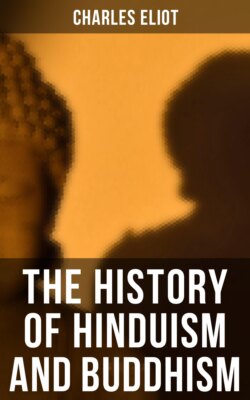Читать книгу The History of Hinduism and Buddhism - Charles Eliot - Страница 25
На сайте Литреса книга снята с продажи.
19. The Origin of Evil
ОглавлениеTable of Contents
The reader will have gathered from what precedes that Hinduism has little room for the Devil[72]. Buddhism being essentially an ethical system recognizes the importance of the Tempter or Mâra, but still Mâra is not an evil spirit who has spoilt a good world. In Hinduism, whether pantheistic or polytheistic, there is even less disposition to personify evil in one figure, and most Indian religious systems are disposed to think of the imperfections of the world as suffering rather than as sin.
Yet the existence of evil is the chief reason for the existence of religion, at least of such religions as promise salvation, and the explanation of evil is the chief problem of all religions and philosophies, and the problem which they all alike are conspicuously unsuccessful in solving. I can assign no reason for rejecting as untenable the idea that the ultimate reality may be a duality—a good and an evil spirit—or even a plurality[73], but still it is unthinkable for me and I believe for most minds. If there are two ultimate beings, either they must be complementary and necessary one to the other, in which case it seems to me more correct to describe them as two aspects of one being, or if they are quite separate, my mind postulates (but I do not know why) a third being who is the cause of them both.
The problem of evil is not quite the same for Indian and European pantheists. The European pantheist holds that since God is all things or in all things, evil is only something viewed out of due perspective: that the world would be seen to be perfect, if it could be seen as a whole, or that evil will be eliminated in the course of development. But he cannot explain why the partial view of the world which human beings are obliged to take shows the existence of obvious evil. The Hindus think that it is possible and better for the soul to leave the vain show of the world and find peace in union with God. They are therefore not concerned to prove that the world is good, although they cannot explain why God allows it to exist. The Upanishads contain some myths and parables about the introduction of evil but they do not say that a naturally good world was spoilt[74]. They rather imply that increasing complexity involves the increase of evil as well as of good. This is also the ground thought of the Aggañña Sutta, the Buddhist Genesis (Dig. Nik. XXVII.).
I think that the substance of much Indian pantheism—late Buddhist as well as Brahmanic—is that the world, the soul and God (the three terms being practically the same) have two modes of existence: one of repose and bliss, the other of struggle and trouble. Of these the first mode is the better and it is only by mistake[75] that the eternal spirit adopts the latter. But both the mistake and the correction of it are being eternally repeated. Such a formulation of the Advaita philosophy would no doubt be regarded in India as wholly unorthodox. Yet orthodoxy admits that the existence of the world is due to the coexistence of Mâyâ (illusion) with Brahman (spirit) and also states that the task of the soul is to pass beyond Mâyâ to Brahman. If this is so, there is either a real duality (Brahman and Mâyâ) or else Mâyâ is an aspect of Brahman, but an aspect which the soul should transcend and avoid, and for whose existence no reason whatever is given. The more theistic forms of Indian religion, whether Sivaite or Vishnuite, tend to regard individual souls and matter as eternal. By the help of God souls can obtain release from matter. But here again there is no explanation why the soul is contaminated by matter or ignorance.
It is clearly illogical to condemn the Infinite as bad or a mistake. Buddhism is perhaps sometimes open to this charge because on account of its exceedingly cautious language about nirvana it fails to set it up as a reality contrasted with the world of suffering. But many varieties of Indian religion do emphatically point to the infinite reality behind and beyond Mâyâ. It is only Mâyâ which is unsatisfactory because it is partial.
Another attempt to make the Universe intelligible regards it as an eternal rhythm playing and pulsing outwards from spirit to matter (pravritti) and then backwards and inwards from matter to spirit (nirvritti). This idea seems implied by Śankara's view that creation is similar to the sportive impulses of exuberant youth and the Bhagavad-gîtâ is familiar with pravritti and nirvritti, but the double character of the rhythm is emphasized most clearly in Śâkta treatises. Ordinary Hinduism concentrates its attention on the process of liberation and return to Brahman, but the Tantras recognize and consecrate both movements, the outward throbbing stream of energy and enjoyment (bhukti) and the calm returning flow of liberation and peace. Both are happiness, but the wise understand that the active outward movement is right and happy only up to a certain point and under certain restrictions.
That great poet Tulsi Das hints at an explanation of the creation or of God's expansion of himself which will perhaps commend itself to Europeans more than most Indian ideas, namely that the bliss enjoyed by God and the souls whom he loves is greater than the bliss of solitary divinity[76].
